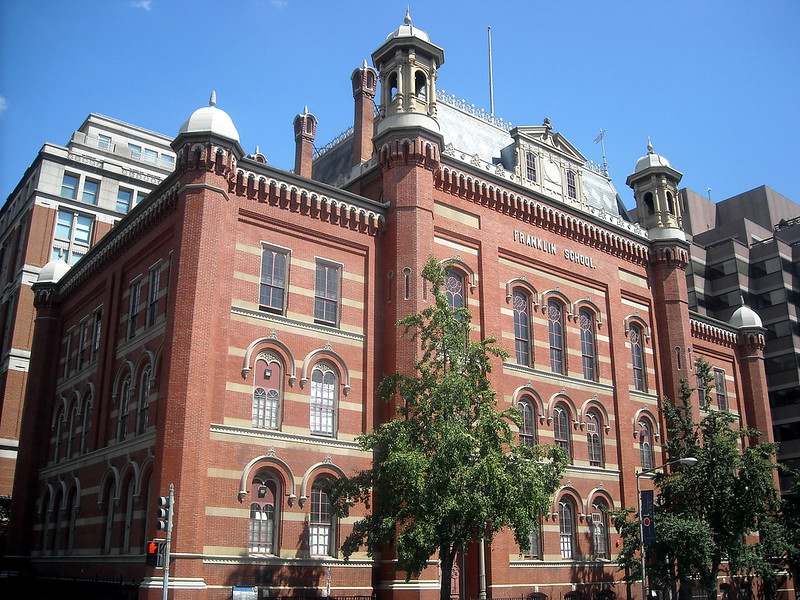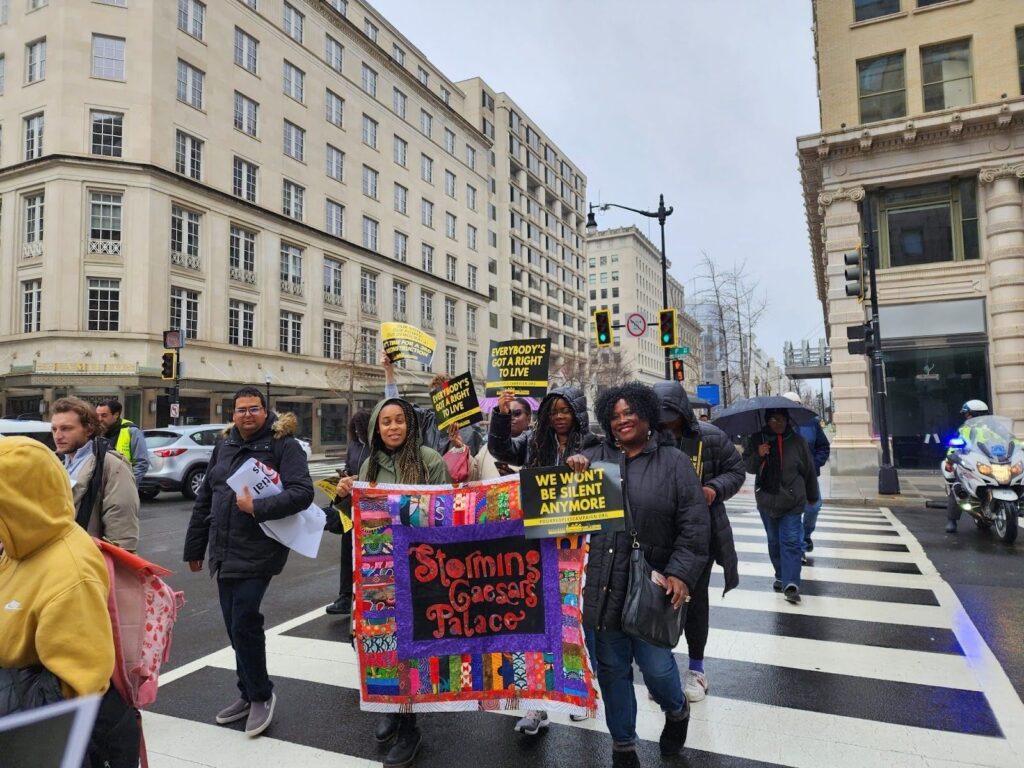Eric Sheptock, Artist/Vendor
In the past, homeless advocacy in the District has been limited in its effectiveness due to people’s tendency to react to specific situations as opposed to creating a sustained movement. Many are they who will rise to the occasion so as to solve a problem when there is a sense of urgency. Few are they who will remain involved so as to change the system that created the problem, thus solving it for once and for all.
Such was the case with the threat from then-D.C. mayor Anthony Williams to close the Franklin School Shelter in 2006. Scores of people came out to support the homeless men who would’ve been left without shelter or housing. However, once the threat was gone, so were all of the activists who stood with us against the Williams administration. As it turns out, Franklin School Shelter was closed by the present mayor, Adrian Fenty. There is a lesson in all of this: that the problem is with the system, not the individual politician. Therefore, while appreciating the small victories for what they’re worth, we must not stop there but must vie for a completely new system.
The fact of the matter is that it has been extremely difficult to keep morale up and to keep the homeless fighting for their rights and for comprehensive solutions to homelessness. They are an extremely disenfranchised lot of people, and not without good reason, considering the treatment they often receive from the general public and government in particular. But the good news is that I see a sustained fight beginning to take place in Washington, D.C.
There are new homeless advocacy groups rising within our nation’s capital. More and more people are angered by how the homeless get treated. With our economy being what it is right now, people are becoming increasingly aware of the fact that we are all “just a paycheck away” from being homeless. While my time is consumed in going to many meetings, I remind myself constantly that it’s all part of building a movement.
After the Committee to Save Franklin Shelter (CSFS) won its victory in March of 2007 following a nine-month fight against former D.C. Mayor Tony Williams, it was incorporated as a nonprofit under the name Until We’re Home, Inc. (www.untilwerehome.org), which went belly up in late January 2008. On April 2, 2008, Mayor Adrian Fenty announced plans to close the same shelter.
Taken together, this means that CSFS/Until we’re Home, inc’s time had come but they’d already disbanded. In late July 2008, a new group of homeless people pulled together and reused the name of the Committee to Save Franklin Shelter. Though Franklin has been closed since September of last year, the committee has broadened its goal to one of addressing all mistreatment of D.C.’s homeless.
However, there are other groups and individuals with similar goals. A couple of pro bono lawyers have joined forces with CSFS. Yet another group, the Homeless Emergency Response Workgroup, has formed to address the injustices involved in D.C. Government having shut down other shelters, thus forcing even more people into the elements. A group of homeless advocates has begun to meet with the District’s Department of Employment Services (D.O.E.S.) to develop an employment program that is tailored to helping the homeless find jobs. My church (the Church of the Epiphany, at www.epiphanydc.org) has created a Justice Ministry Team that is designed to interact with the homeless, learn about the issues and develop a plan to bring them justice and possibly end their homelessness.
Then there are the agencies that have been around for five years or more. My friends at Empower DC are fighting for affordable housing, and they have a campaign to make D.C. government use public buildings and land for public needs rather than giving it away to greedy developers. The Fair Budget Coalition is influencing government to allocate funds for various social services including shelter, housing and literacy programs. The Washington Legal Clinic for the Homeless offers free legal services and legal advice to the homeless. The list goes on.
I’d be remiss were I to fail to mention all of the concerned citizens who don’t belong to a named group or agency. Many do-gooders go to the parks to feed the homeless. Of late, these groups have been making it a point to stay and talk to the homeless at length about their issues and to get to know them. It reminds me of the song Mr. Wendal in which the group Arrested Development advised Americans to get to know the homeless rather than looking down on them. Add to that the number of people that view my blog and other homeless blogs. Many people have googled “homelessness in DC,” found my blog and interviewed me about the homeless situation in our nation’s capital. This has enabled me to give the mayor a lot of bad publicity.
I recently received what might be the final word on yet another shelter closure. The CCNV shelter has been in a contract dispute with the city since February of this year. The latest word is that the contract might not be renewed. If this proves to be true, D.C. Mayor Fenty will have the fight of his life on his hands. Those people who need an urgent situation to react to in order get involved may soon have what they need.
Washington, D.C. has a rich history of the homeless fighting the powers that be. As it turns out, only a few of the fighters from that era are still with us. Nonetheless, I see many components coming together so as to rebuild the movement. Hopefully this time around we’ll be able to effect complete systemic change. La lucha continua.
Jesse Smith, Artist/Vendor
Like a bad penny, the issue of the Franklin School building in downtown Washington keeps coming back. The fate of this property, which until fall 2008 offered emergency shelter to over 300 homeless men, is still unknown.
On April 7, the District’s Office of Property and Management (OPM) issued a Request for Offers (RFO) for the Reuse of District of Columbia Public Schools (DCPS) Excess Space, specifically the Franklin School building. It’s great to see things happening in downtown Washington. But the decisions the District makes about using this prime downtown property, and what we do for poor people and young people across the city, will say a lot, too.
When I received an e-mail announcing that the Franklin building was being offered to Charter Schools, I was delighted. For this building to morph from a shelter, a use for which it was not designed, into an instrument of education had me raising my fist in triumph, proclaiming that this is truly a good thing.
This is certainly a positive and much needed step to increase the level of education for our children here in D.C., I thought.
But my friends at EmpowerDC checked into the implications of the government’s action and did not take it at face value as did I.
To show how we got to this point, I should give a bit of background.
An organization called the Committee to Save Franklin Shelter, and a few other activist groups, were involved in a long effort to prevent the closing of the Franklin shelter in 2006. Mayor Anthony Williams had proposed leasing the building to a developer who wanted to operate a luxury hotel within the historic Franklin School building.
His idea as it turned out was received with stiff opposition from many advocacy groups as well as the general public. We succeeded in keeping the facility functioning as a shelter for some two years.
Now our new mayor, Adrian Fenty, has done what Mayor Williams never did: Franklin School sits idle and unoccupied in a highly desirable location in downtown Washington, D.C. In a masterful bureaucratic stroke, Mayor Adrian Fenty has relieved D.C., for the sake of the tourist industry and a few supportive City Council members, of what they would consider an eyesore to the image of Washington.
Still, many advocates and organizations have been keeping a watchful eye on the sale or disposition of public property. And the City Council is thinking about legislation to make the process more open.
And if Franklin does go to a charter school, there will still be serious questions about how this will work.
For example, the District government might have to allocate funds to bring the building up to code for use as a school. Would those funds be taken from our already deteriorating public schools? Money spent on a charter school at Franklin would do nothing for a public school in far Southeast or Northeast.
I also want to point out that the city is legally bound, by congressional mandate, to offer the Franklin School property to charter schools first. So it isn’t as though the mayor had some epiphany that he should offer this property to charter schools. It is in fact mandated that he do so.
To put it another way, this was an automatic move. And we don’t know how effective it is in supporting education. The city could very well be just fulfilling a legal obligation by putting the property up for charter school bid first. That doesn’t guarantee that it will end up as a charter school.
Given that our mayor has exhibited time and time again that he prefers to act in a dictatorial fashion, ignoring on many occasions the City Council itself, we should keep a watchful eye on the new proposed action concerning the disposition of the historic Franklin School.
A lot of people have expressed their concerns about public property at hearings. They’re looking for an open process and for decisions that help everyone in Washington.
And we still haven’t solved the problem of shelter in downtown Washington, D.C.








